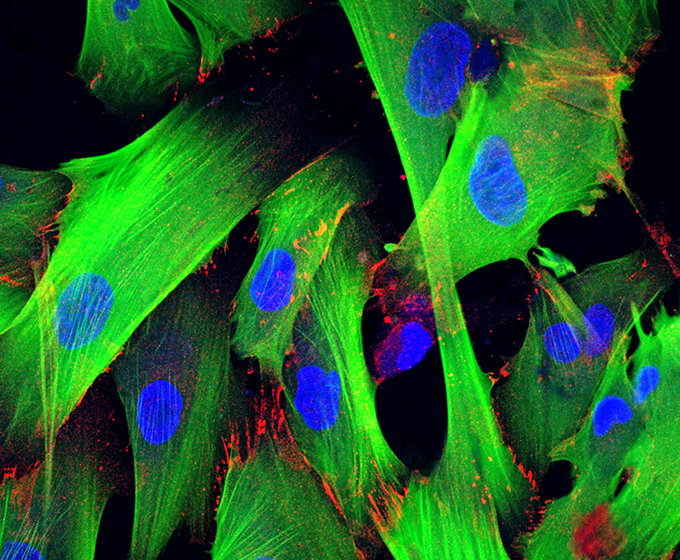
NOVEMBER 13, 2020 — Researchers around the world now have access to an open-access software designed to further characterize cytoskeleton filaments.
Most computational neuroscience software centers around neuronal network systems. Marcelo Marucho, an associate professor in the Department of Physics and Astronomy, designed a software that focuses on fundamental research of how a single neuron performs important biological functions depending on the polyelectrolyte properties of cytoskeleton filaments.
The Java Application for Cytoskeleton Filament Characterization (JACFC) provides comprehensive computer models and high-performance algorithms to elucidate the molecular mechanisms modulating the electrical signal propagation, stability and bundle formation of microtubules and F-actin filaments under different molecular and environmental conditions.
Ultimately, these studies may discover whether molecular and cellular alterations substantially alter the equilibrium of interactions and trigger abnormalities in the bundling and signal propagation during various disease states.
Pathological conditions like Alzheimer’s were historically studied at the larger scale brain system, based on losing the ability to communicate between neurons.
“This happens because in principle the neuron is losing the ability to process information and then can’t transmit it to the other neurons,” Marucho said. “The application [of JACFC] is to find the origin of this.”
Marucho’s research focuses on how the calcium ions carry information from the membrane to the centrosome to other compartments in the neuron. Exactly how the centrosome is able to receive an external stimulus and send instructions to perform a cellular function is not well known.
He investigates the cytoskeleton filament inside the neuron, a biopolymer which is a conductor of electricity. The F-actin filaments and microtubules generate a network inside the neuron. They may aggregate and form a parallel, perpendicular or other configuration.
“In the past, scientists only looked at the mechanical properties of this network, not electrical properties,” Marucho said. “The mechanical properties may generate the shape of the neuron and may also be a stick where they can move particles from one compartment to another. But now we are saying they are also very good conductors.”
The JACFC will help scientists understand how a neuron processes information in order to perform biological functions. This will help them understand how a neurological disease affects information processing.
When developing JACFC, Marucho’s goal was to create a forum for people to learn about this topic and share their research. JACFC is unique because it is designed to be accessible to both experts and non-experts in the field. A visualized guide is provided so users can perform calculations online without computational restrictions.
“The more people that are investigating on cytoskeleton filaments, the more we will learn,” Marucho said.
UTSA Today is produced by University Communications and Marketing, the official news source of The University of Texas at San Antonio. Send your feedback to news@utsa.edu. Keep up-to-date on UTSA news by visiting UTSA Today. Connect with UTSA online at Facebook, Twitter, Youtube and Instagram.
Move In To COLFA is strongly recommended for new students in COLFA. It gives you the chance to learn about the Student Success Center, campus resources and meet new friends!
Academic Classroom: Lecture Hall (MH 2.01.10,) McKinney Humanities BldgWe invite you to join us for Birds Up! Downtown, an exciting welcome back event designed to connect students with the different departments at the Downtown Campus. Students will have the opportunity to learn about some of the departments on campus, gain access to different resources, and collect some giveaways!
Bill Miller PlazaJoin us for an intimate evening of cocktails, conversation, and culinary inspiration with Pati Jinich, Emmy-nominated chef and James Beard Award-winning author. Enjoy light bites and signature drinks in the warm, modern setting of Mezquite as Pati connects with guests over her passion for Mexican cuisine and storytelling.
Mezquite Restaurant in Pullman Market, 221 Newell Ave., San Antonio 78215From inspired courses to thoughtful pairings and a rich sense of community, the Ven a Comer Signature Dinner is a night of shared meals, shared stories, and unforgettable flavor.
Stable Hall (Pear Brewery), 307 Pearl Pkwy, San Antonio 78215Come and celebrate this year's homecoming at the Downtown Campus with food, games, giveaways, music, and more. We look forward to seeing your Roadrunner Spirit!
Bill Miller PlazaThe University of Texas at San Antonio is dedicated to the advancement of knowledge through research and discovery, teaching and learning, community engagement and public service. As an institution of access and excellence, UTSA embraces multicultural traditions and serves as a center for intellectual and creative resources as well as a catalyst for socioeconomic development and the commercialization of intellectual property - for Texas, the nation and the world.
To be a premier public research university, providing access to educational excellence and preparing citizen leaders for the global environment.
We encourage an environment of dialogue and discovery, where integrity, excellence, respect, collaboration and innovation are fostered.